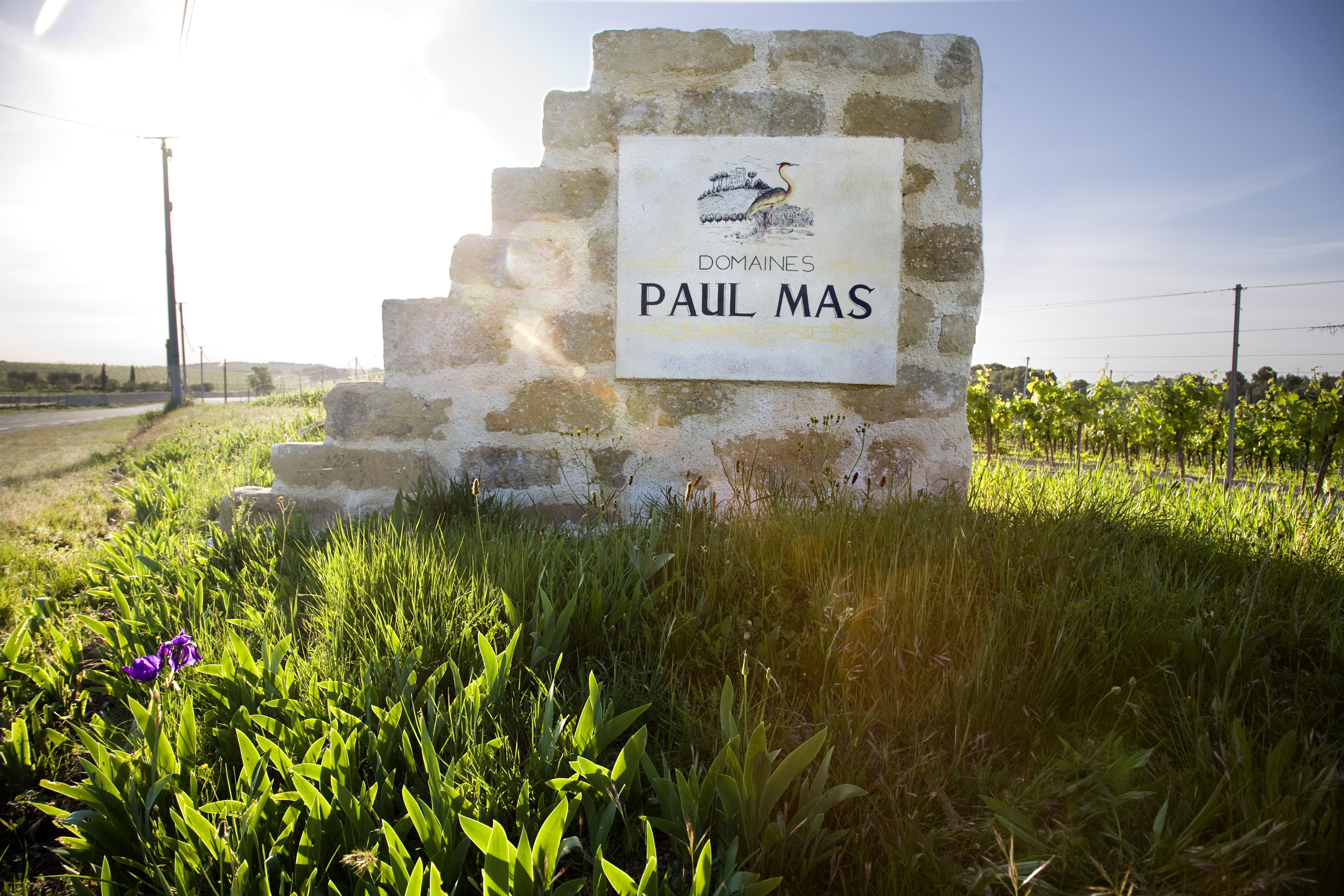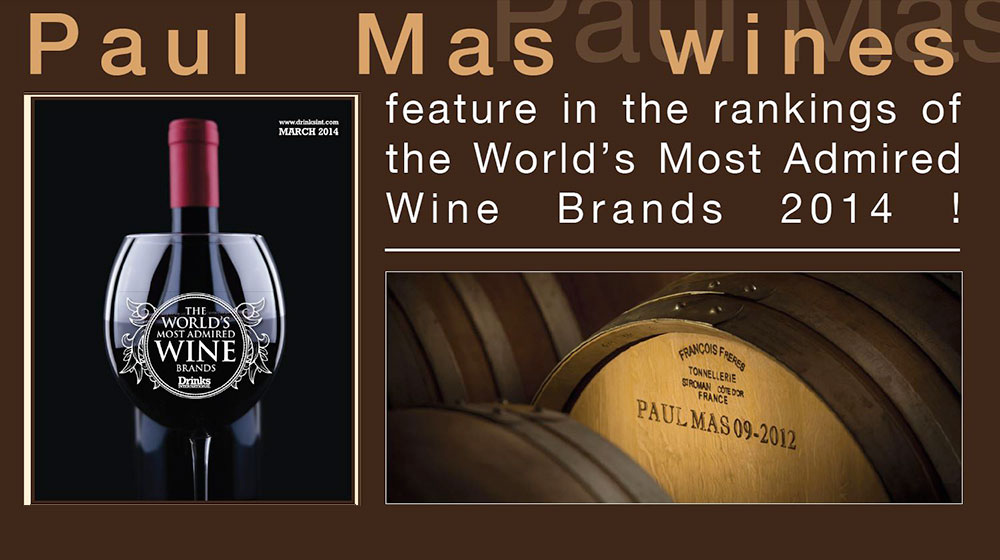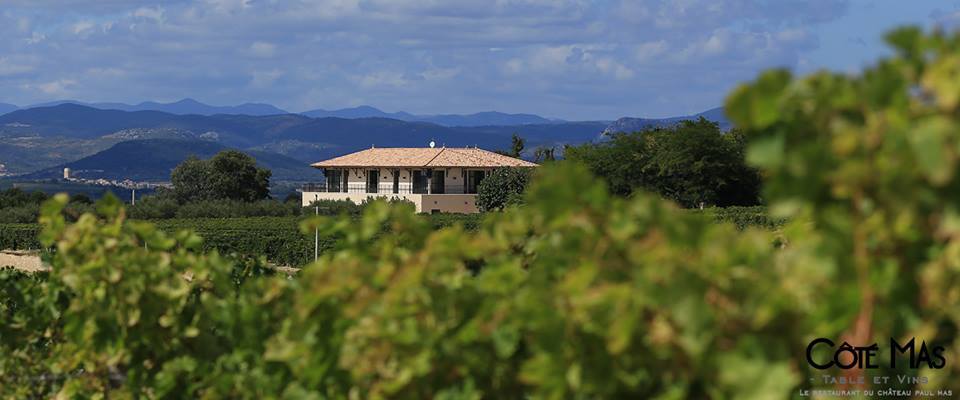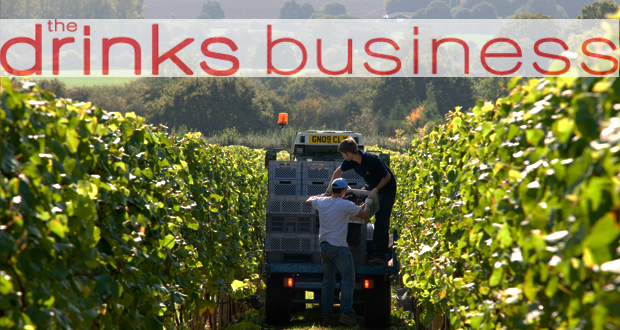
Click here to download our full vintage report.
Mother Nature showed a particularly mischievous streak in the Languedoc this year, imparting an unusual character to the vintage. Fruity, fresh and eminently drinkable, 2014 is looking like a savoury vintage, an Umami* vintage (savoury and enjoyable).
The climatic conditions of the 2014 vintage
A dry, mild winter, and spring much the same, pointed towards an early vintage. Not since 1950 had there been such a mild winter. Budburst commenced 20 days earlier than last year. The mild conditions throughout winter and spring were also particularly dry in west Hérault and east Minervois, with 50% less available water levels in the soils than usual. In the most affected areas, the vines suffered from hydric stress very early on in the season, which in turn affected growth and limited production. The Gard and Aude were spared this severe water shortage.
Summer also had a few surprises in store and was exceptionally cool, with much lower maximum temperatures than usual, while rainfall varied dramatically depending on the area (from 30-200mm). Cool summer temperatures slowed growth in the vine, putting an end to any head start noted at the onset of the season. Ripening commenced even later than in 2012 and 2011, and in places was only slightly earlier than 2013, which was the latest vintage of the last 40 years.
The last chapter of this capricious year came in September, with an Indian summer appearing to set in during the first two weeks. Conditions alternated between glorious, hot, sunny weather during the day, with temperatures in excess of 30C accompanied by gentle winds, and very cool nights. These diurnal temperature variations promoted synthesis of aromas and anthocyanins and in turn accelerated ripening in the grapes, which required careful monitoring in order to commence harvesting at the optimum time. From mid-September onwards, the glorious Indian summer was brought to a dramatic close by the unusual occurrence of two fronts of rain, in quick succession, with 100-300mm accumulated rain falling on September 15-19, September 28-29, October 6-7 and finally October 9-12. The rain was very localised, a phenomenon previously experienced in 2002, 2006 and 2009, which are all vintages with particularly good ageing potential.
Reduced Volumes
The accumulative effect of an early drought in the Hérault, unexpected spring frost in the Étang de Marseillette and frost or hail damage took its toll on yields and Chardonnay, Merlot and Syrah were the most affected. The Hérault region saw a 25-35% fall in volume. In the Limoux and the Gard, where winter and spring rainfall provided the vines with generous water supplies, volumes were 5% lower than average.
Ripening conditions
Early ripening varieties such as Sauvignon Blanc, Chardonnay and Pinot Noir enjoyed ideal ripening conditions, and reveal magnificent balance and pronounced aromatics. Cévennes rainfall complicated vintage planning for the later ripening varietals. We had to take risks and avoid panic. Intermittent periods of fine, sunny weather encouraged us to wait for the grapes to reach optimum ripeness, which was possible since the grapes were also healthy. Ripening was also affected by variable yields. The grapes ripened very rapidly in low-yielding sectors, while the more high-yielding varieties such as Grenache, Carignan and some of the Syrah matured much more slowly.
Two tiered harvesting
Harvesting commenced August 8 for the sparkling base wines (IGP d’Oc) around Béziers, followed by the Sauvignon Blanc and Chardonnay from August 20 onwards, which is an average start date for these varietals. During the first two weeks, harvesting maintained a steady pace, as the grapes were ripening quickly. From mid-September however, rainy weather slowed the pace and extended harvesting, which drew to a close October 18, making 2014 a relatively late harvest.
Wine style
The 2014 vintage is characterised by very well balanced fruit and acidity. Good ripening conditions for the earlier varietals created outstanding aromatic expression. The alcohol content, which was relatively average last year, has returned to levels seen in previous vintages: 12.5% alc/vol for the Sauvignon Blanc, 13.5-14% for the Chardonnay and 13.5-14.5% for the reds. High levels of malic acid will no doubt be the trademark signature of this vintage. In the white wines, levels were twice as high as last year, resulting in a more Burgundian, rather than Mediterranean character to the wines. To balance the acidity and retain the freshness, this year we trialled the use of Schizosaccharomyces yeasts, which are often used in Champagne and ferment malic acid, enhancing aromatic complexity.

Jean-Claude Mas will be with us to present our portfolio of wines at the London Wine Fair, Olympia. He will be joining us to showcase favourite brands such as Arrogant Frog , including the Astelia range, the new single varietals from the Côte Mas range and the newly acquired Domaine Ferrandière.
TOP 5 HIGHLIGHTS ON DOMAINES PAUL MAS STAND C61 AT LONDON WINE FAIR 2014
– 1 Domaine de la Ferrandière:
Jean-Claude Mas has continued to expand by upping the number of his signature estates to 8, adding the 100 ha Domaine de la Ferrandière property to his estates. 70 of these ha are planted with vines, at Aigues-Vives in the Aude region between Corbières and Minervois. Nestling within a former maritime lagoon, this unique limestone-clay soil is the perfect environment for vine growing and nurtures a special freshness and taste in our wines. Cabernet Sauvignon, Grenache, Malbec, Marselan, Syrah, Pinot Noir, Riesling, Pinot Gris and Viognier flourish here, and these single varietals will be open for sampling.
– 2 Coté Mas single varietal: Following the success of the Côté Mas blends launched in 2012 (red, white, rosé), Jean-Claude Mas is expending the range by adding single varietal such as Vermentino, Chardonnay, Cabernet Sauvignon and AOPs (Languedoc Red, Languedoc White, AOP Pézénas) – just like the blends, these will all be packaged with striking Art Deco labels in the vibrant colours of the Languedoc.
– 3 Sparkling wines: Following the acquisition of Chateau Martinolles in Saint-Hilaire (Limoux) in 2009, Jean-Claude and his team have put significant effort into the production of sparkling wines such as Blanquette de Limoux and Crémant de Limoux. With trends in the UK indicating continued growth for the sparkling category, Jean-Claude is launching a 100% Chardonnay BRUT and an Organic Crémant de Limoux.
– 4 Astelia range: This high-end range of wines is named after and dedicated to Jean-Claude Mas’ three daughters – Astrid, Elisa and Apolline. When asked why he chose to name the Astelia range after his daughters, Jean-Claude’s response in a nutshell “my wine and my girls are my finest achievements!”.
Astelia Cabernet Sauvignon, Astelia Chardonnay and Astelia GSM (Grenache, Syrah, Mourvèdre) will be available for sampling.
– 5 New Arrogant Frog packaging: The famous Arrogant Frog will be on our stand with a brand new look! The new packaging includes a different bottle type, the signature of JC MAS on the capsule and an amended label where the Frog is integrated into a vineyard. For Jean-Claude Mas, the aim of the redesign was to “avoid Arrogant Frog being confused with any critter labels and give Arrogant Frog a winemaker identity”.

In March 2014, Domaines Paul Mas was ranked #30 World’s Most Admired Wine Brands in Drinks International and #17 European Brand.
This year, the Academy of experts who presided over the judgement of an impressive number of wines for all over the world decided to reward the work carried out by Domaines Paul Mas, where traditional winemaking skills blend with New World attitude. International buyers, sommeliers, journalists and masters of wine were asked to provide their professional opinion following the criteria below:
· Is the wine of consistent or improving quality?
· Does it reflect the region or country of origin?
· Does it respond to the needs and tastes of its target audience?
· Is it well marketed and packaged?
· Has it got a strong appeal to a wide demographic?
Domaines Paul Mas have become a point of reference for the wine of Southern France. The Mas family has been cultivating grapes since 1892 and has steadily continued to extend its vineyards over a patchwork of rich and varied soils. Today, head of the family business Jean-Claude Mas has established himself as a key player in the new wave of vibrant Languedoc-Roussillon wines.
The impressive CV of the Paul Mas wines:
· Available in 58 countries
· 300 medals already awarded in the last 5 years
· 50 Gold medals awarded in the last 3 years
· An 8th estate acquired in 2013.

Domaines Paul Mas Vintage Report
2013: The Languedoc Makes Its Mark
If there is one wine region which has done well in France this year, it is certainly the Languedoc. While other regions have had to cope with complex climatic conditions in what has been a relatively late harvest, the Languedoc has actually benefitted from albeit atypical weather conditions, particularly when it comes to the full ripening of the grapes. Of course, good vineyard management and yield control are of paramount important to Domaines Paul Mas. 2013 has all the hallmarks of an extraordinary vintage. Wines are showing superb aromatic potential and exceptional freshness, promising excellent ageing potential.
The climatic conditions of the 2013 vintage:
There were quite a few surprises this year….
– A cold winter delayed the beginning of the growing season
– Extremely low temperatures over a long period of time, up until May 2013, made this the coldest winter in 20 years
– A warm Indian summer followed a very good hot summer season
Although it missed out on a mild spring, the region basked in a very sunny, warm summer with above-average temperatures in July. In September and October, crucial months for the vintage, the conditions were ideal; hot sunny days and fresh, cool nights.
The right amount of rain to sustain the vines
Recorded rainfall has varied from one terroir to the next. While in Limoux, the vineyards received plenty of rain in the winter period, the vineyard in the Hérault Valley have been coping with drought despite several rainstorms in March which have lead to significant rainfall readings across the board: from 120 to 250mm which is 2 – 3 times the normal seasonal measurement. In spring and summer, rainfall varied greatly from one region to the next, some reporting more than usual while elsewhere, water was in short supply. September and October were mainly dry with a few localized outbreaks of rain.
On the 6th and 7th September, there was a very heavy rainstorm in the Biterrois region (from 50 to 80 mm)
On the 14th September, there was another outbreak of rain although this time it was less violent (5 to 15mm)
On the 4th and 5th October, the Aude region received a large fall of rain (20 to 50mm)
Unusually for the region, the water reserves in the soil have been sufficient to sustain the vines well; another reason why this vintage really stands out.
Each sub-region within the Languedoc has its own more specific data. We harvest fruit from a number of different terroirs across the region including:
– Limoux
– Lower Aude Valley and the Marseillette Basin
– Minervois
– Pézenas and the Hérault Valley
– Grès de Montpellier
– Béziers and the Orb Valley
Limoux
Spring 2013 was exceptionally cool. In May and June, the average temperature was nearly 3˚C below the seasonal average: 13.3˚C in May and 17.8˚C in June. Summer, on the other hand, was hotter than the average but even so, it did not make up for the delay of the growing season caused by the cold spring weather conditions. Another feature of the vintage; high levels of winter rain. In the month of January alone, recorded rainfall was 138mm, while the average was nearer to 60mm. Throughout spring, there was regular light rainfall so the team were particularly vigilant in case disease or rot set in.
Lower Aude Valley and the Marseillette Basin
Spring was generally quite rainy but the summer months were on the whole dry with some light rain in September and mid October. Spring was cool while summer was hot.
Minervois
Spring: 180 – 250˚mm
Summer: 30 – 50˚mm
Winter rainfall was higher than normal (+15% – +35%). Most of the rain fell in spring. Summer was generally dry. Spring was very cool and summer very hot with temperatures higher than average.
Biterrois
Spring: 100 – 160˚mm
Summer: 20 – 40˚mm
Summer rainfall was low but rain storms at the beginning and in the middle of September created the right conditions for botrytis to take hold in certain parcels where vines were more densely planted, which required very careful monitoring to track the maturation process. Spring was cool and summer was generally hot.
Lower Hérault Valley
Spring: 110 to 180mm
Summer: 30 – 60mm
Rainfall was close to average in spring and slightly lower than average throughout the summer period.
Grès de Montpellier
Spring: 150 – 200mm
Summer: 100 – 120mm
There was some rain in spring but in summer, there was an unusual amount of rain. This is the only part of the region where there was too much rain. Heavy rain fell overnight between 28th and 29th July: 50 – 95mm/hour.
Orb Valley
Spring: 220 – 280mm
Summer: 80 – 100mm
This part of the Hérault is generally cooler and more humid than the rest of the region. Rainfall readings were average this year.
The Growing Season
The hard winter and the persistently low temperatures until the end of May have significantly impacted on the vegetative cycle of the vines. Budbreak was delayed by almost two weeks but the conditions in April and May are mainly responsible for the slow growth of the vines and late flowering, some 10 – 15 days behind the average date. Cold weather during flowering resulted in some coulure for certain susceptible varieties such as Grenache and Merlot, while Chardonnay was affected by millerandage, particularly in Limoux. The Paul Mas team has managed to minimize the effect of these problems by using preventative treatments with oligo elements.
Healthy grapes; the key to the quality of the vintage
Due to the relatively wet summer, it was necessary to keep a close eye on the vineyards to prevent diseases such as mildew and oidium. “It has been a year where we couldn’t make any mistakes,” comments Bastien Lalauze, winemaker in charge of the vineyards at Domaine Martinolles in Limoux. By proactively treating the vines at exactly the right time, we have been able to harvest really high quality grapes.
“Vineyard management was the most important factor that determined the quality of the vintage this year. Thanks to our efforts, we have been able to work around the difficulties of a late season,” says Jean-Claude Mas.
A harvest brought in in record time
2013 has been the latest vintage in 20 years. Picking began on the 5 September for the first varieties to fully ripen, about 15 days later than the average. This delay was less critical for the later ripening varieties, picked about a week later than the average. Consequently, the harvest was completed more quickly than usual. While it normally lasts from 15th August to 15th October, picking took place at a very brisk pace between 5th September and 23rd October. The unusual conditions for maturation have upset the norms.
“2013 has been like a Burgundian vintage,” comments Guillaume Borrot. Ripening was slow because the days were shorter and the nights were very cool. These were ideal conditions for fast-ripening grapes like Sauvignon Blanc and Pinot Noir, varieties which have produced exceptional aromatic intensity this year.”
Profile of the wines by grape variety
Sauvignon Blanc
2013 has been a great year for Sauvignon Blanc. This variety benefitted from the levels of available water and the swings in temperature between day and night – two key factors contributing to its aromatic potential. The ripening period was unusually long; the last of the Sauvignon Blanc was picked on 24th September. The 2013 Sauvignon Blanc has great aromatic intensity, showing citrus fruit, tomato leaf and tropical fruit, together with good acidity and freshness.
Alcohol: 12 – 12.5% vol
Acidity: 4g/l
pH: 3.30
Chardonnay
Due to the unusual weather conditions, Chardonnay from this year will be much more crisp and lively than one would expect from the Languedoc. Wine styles vary greatly from one area to the other and there are some quite big differences in sugar levels. Because we are operating in a broad range of terroirs, we are able to blend different parcels to maintain the styles of our wine ranges. With the Chardonnay from the flatter areas, we aimed to harvest the grapes fully ripe in order to get wines with body and texture. In the cooler regions like Limoux, where the wines are naturally more austere, we have applied a malolactic fermentation on a proportion of the wines in order to achieve aromatic complexity, texture and body. Due to the generally higher acidity levels, barrel fermentation was a good option and the ageing potential of the wines is looking promising.
Alcohol: 12.5 – 14% vol
Acidity: 3.6 – 3.8g/l
Ph: 3.4
Viognier
This variety will have a crisp, lively character this year. This freshness will bring out very delicate floral and apricot aromas more typical of the wines of the Northern Rhône.
Alcohol: 13%
Acidity: 3.6 – 3.8g/l
pH: 3.4
Vermentino
The Vermentino crops managed to resist vine diseases so have reached full maturity, producing very expressive wines with aromas of bergamot and pear. As usual with the variety, there is an excellent balance between alcohol and acidity.
Alcohol: 12.5 – 13%
Acidity: 3.5g/l
pH: 3.3 – 3.4
Marsanne
This variety was also picked in a very good state. The conditions were just right to produce wines with lots of freshness – something which we always look for with Marsanne.
Alcohol: 13%
Acidity: 3.4g/l
pH: 3.5 – 3.6
Picpoul
It has been a great vintage for this variety which is concentrated in the Thau basin. Volume and quality combine perfectly with a very lively character, key elements for a successful Picpoul wine. To add texture and complexity, we kept the wines on the lees and stirred throughout the fermentation.
Alcohol: 12.5%
Acidity: 3.8g/l
pH: 3.2 – 3.3
Grenache Blanc
This great Mediterranean variety has once again surpassed itself, more proof that it is perfectly suited to the terroirs of the Languedoc. We brought the grapes in fully ripe with excellent aromatic potential. Aromas of flowers and white peach marry harmoniously with the spicy notes from barrel fermentation and maturation.
Alcohol: 13%
Acidity: 3.5 – 3.8g/l
pH: 3.3 – 3.45
Blanquette et Crémants
This has been a dream vintage for the Blanquettes and Créments de Limoux. The harvest kicked off on the 5th September, 15 days later than last year. But the weather conditions of 2013 have been absolutely perfect in terms of finding the acidity levels necessary to make sparkling wines. The base wines combined the two most important criteria for making quality sparkling wines – fruit and acidity. The quality of the grapes has produced very clean, structured wines with excellent aromatic intensity. The 2013 bubbles from Limoux are looking very promising indeed!
Alcohol: 10.5 – 11%
Acidity: 4.5 – 5g/l
pH: 3 – 3.1
Rosé
2013 will be an exceptional year for Languedoc Rosé which is showing the two most important qualities for this wine style: fruit intensity and freshness. The Rosés of 2013, fermented at low temperatures, have crisp, fresh summer fruit aromas and flavours. Lively in character, they are rich, ripe and deliciously fresh.
Alcohol: 13%
Acidity: 3.5 – 3.6g/l
pH: 3.3 – 3.4
Pinot Noir
If there is a grape that is better suited to the specific weather conditions of this vintage then it is Pinot Noir. The reason? Water levels and temperatures have been more akin to those of its region of origin – Burgundy. The late vintage was absolutely ideal for this early ripener which has really flourished with the water levels and lower temperatures throughout the growing and ripening seasons. Supple tannins, full body and exceptional aromatic complexity with notes of red fruit and cherry. Languedocien Pinot Noir is a must this year.
Merlot
Merlot struggled with the cool conditions around flowering time which led to some coulure and millerandage. Consequently, the harvest has been smaller but in return the grapes reached optimum maturity and are extremely concentrated in flavour and colour. In Limoux, in particular, Merlot has explosive concentrations of aroma; forest fruits and truffles with ripe tannins.
Alcohol: 13.5 – 14.5%
Acidity: 3 – 3.2g/l
pH 3.7 – 3.8
Syrah
Terroir is very evident in the Syrahs of 2013 and two very distinct profiles have emerged. For the Syrah from the flatter areas, where yields have been fairly large, we have used certain techniques (from pre-fermentation maceration to hot or thermovinification) to get supple, fruity wines. Syrah from the hillside vineyards have reached a good level of ripeness and are rich and concentrated with velvety tannins and rich red fruit aromas and flavours. They are closer in style to the wines of the Northern Rhône than to the traditional Languedoc Syrah.
Syrah from the flatter areas:
Alcohol: 13.5 – 14% vol
Acidity: 3 – 3.2g/l
pH: 3.7 – 3.8
Syrah from the hillside vineyards
Alcohol: 14 – 14.5% vol
Acidity: 3.2g/l
pH: 3.7
Grenache Noir
This is the variety that has struggled most with the prevailing conditions. Low temperatures at flowering time caused coulure, which we were able to control with preventative treatments of oligo elements. Nevertheless, it was a challenging situation in the vineyard and we have had to do some work on the wines in the cellar in order to push them to their full potential. This year, the Grenache wines are very fruity with lower alcohol levels than usual except for those parcels where the yield was very low and their alcohol levels were at usual levels.
Alcohol: 13.5 – 14.9% vol
Acidity: 3.3 – 2.9g/l
pH: 3.8 – 3.9
Cabernet Sauvignon
Despite the fact that it is a late ripener, Cabernet Sauvignon like Cabernet Franc elsewhere held its own this year. It flourished in the warm Indian summer and in the end, was harvested only a few days later than last year. The calm conditions at the end of the season allowed the Cabernet grapes to ripen slowly and steadily, which has been really beneficial for their aromatic composition. Cabernet from 2013 is rich and supple packed with aromas of forest fruit and red pepper.
Alcohol: 13.5 – 14% vol
Acidity: 3.3 – 3.1g/l
pH: 3.7 – 3.8





